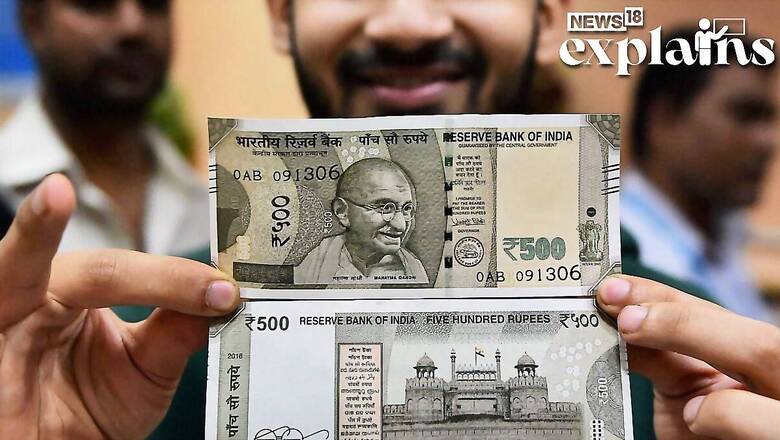
views
The currency notes across the world feature images of their founding fathers or prominent leaders who play a crucial role in the nation’s history. While the currency notes in the US carry the portraits of George Washington and Benjamin Franklin, the Pakistani currency bears the portrait of Mohammad Ali Jinnah, while China features Mao Zedong.
In India, Mahatma Gandhi’s portrait has been in use in the national currency for more than five decades. Though the currency notes featuring Gandhi have been in circulation for past many years, the practice was not prevalent immediately after India’s Independence in 1947. Gandhi’s portrait became a permanent feature on the notes of every denomination only in 1996.
With Gandhi’s birth anniversary (October 2) falling on Monday, here’s a look at the history behind Gandhi’s portrait on banknotes, how it was chosen and why portraits of other leaders are not used.
Origin of Gandhi’s Image
In colonial India, the currency notes used to carry the image of King George VI. After independence, the image of King George was replaced with the national emblem- Lion Capital at Sarnath.
Mahatma Gandhi first featured on the Indian currency notes in 1969 when a series in honour of his 100th birth anniversary was issued. The currency showed Gandhi seated in the backdrop of Sevagram Ashram.
Before Mahatma Gandhi, the currency notes had the image of the Lion Capital of Ashoka in most of the banknotes. Other images like Konark Temple in Odisha (on Rs 20), Brihadeeswara Temple (on Rs 1,000) and Gateway of India (on Rs 5,000 note).
In October 1987, a series of Rs 500 currency notes were released featuring smiling Gandhi. Since then, Gandhi’s portrait has been regularly featured on notes of different denominations.
Finally, in 1996, the Mahatma Gandhi series was issued replacing all the bank notes that were printed until then.
Do the Notes have Original Gandhi’s Image
The portrait of Gandhi visible on Indian currency notes isn’t a caricature. According to a report in The Indian Express, the image is a cut-out of a photograph taken in 1946, where he is standing with British politician Lord Frederick William Pethick-Lawrence.
The photograph was chosen as the most suitable expression of Gandhi smiling and the portrait began to be used in the currency notes.
Why Gandhi’s Image Became a Permanent Feature
The Reserve Bank of India (RBI)’s Department of Currency Management is responsible for designing the Indian currency. The department has to get approval for the designs from the central bank and the Central government.
In the 1990s, the RBI felt that the traditional security features in the banknotes were inadequate in view of the advancements in printing, scanning and photography. Therefore, it was believed that inanimate objects would be relatively easier to forge than a human face.
Gandhi was chosen to be printed in the banknotes because of his national appeal and countrywide acceptance and a new ‘Mahatma Gandhi Series’ was launched in 1996 to replace the former Ashoka Pillar. With a vast and diverse country like India, there can’t be a consensus on a symbol or leader, other than Gandhi. Mahatma Gandhi is not just renowned but also a respected international figure who is widely respected across ideologies and party lines.
The RBI also introduced several security features like a windowed security thread, latent image and intaglio features.
In 2016, ‘Mahatma Gandhi New Series’ of banknotes were announced by the RBI post-demonetisation by the Central government. Though the colour of the notes has been changed, the portrait of Gandhi continues along with the Swachh Bharat Abhiyan logo at the back of the note.
Demand to include others
There have been demands to include the images of popular leaders and Gods and Goddesses on currency notes. However, the RBI had rejected the suggestions to replace Gandhi’s portrait with any other leader on the bank notes.
During a lecture in 2014, former RBI governor Raghuram Rajan was asked why we can’t have scientist Homi J Bhabha or poet Rabindranath Tagore on the rupee notes.
“There are so many great Indians, but of course he (Gandhi), stands head and shoulders above everyone. There are many great Indians that we could get on the notes. But I sense that almost anybody else would be controversial,” Rajan said.
In the same year, then Finance Minister Arun Jaitely while addressing the Lok Sabha had said, “An RBI panel has decided against the inclusion of any other national leader’s image on banknotes saying that no other personality can better represent the ethos of the country than Mahatma Gandhi.”


















Comments
0 comment